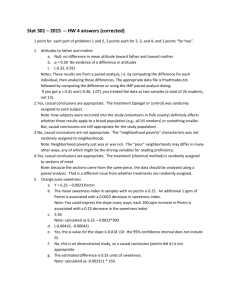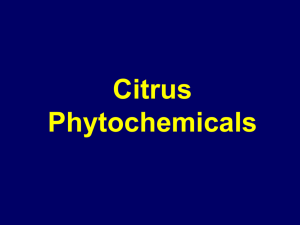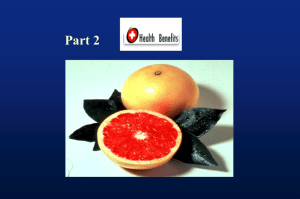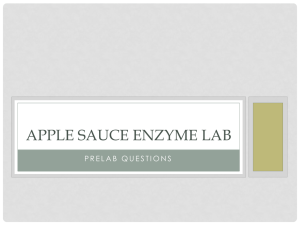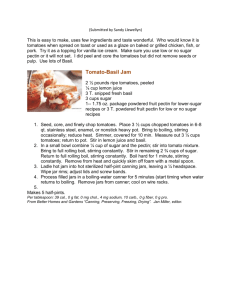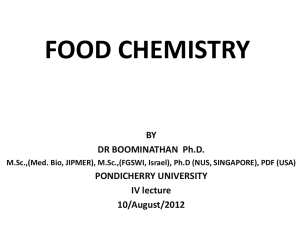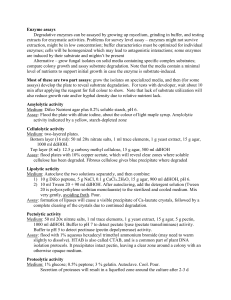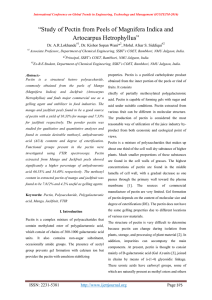Rootstocks - Aggie Horticulture
advertisement
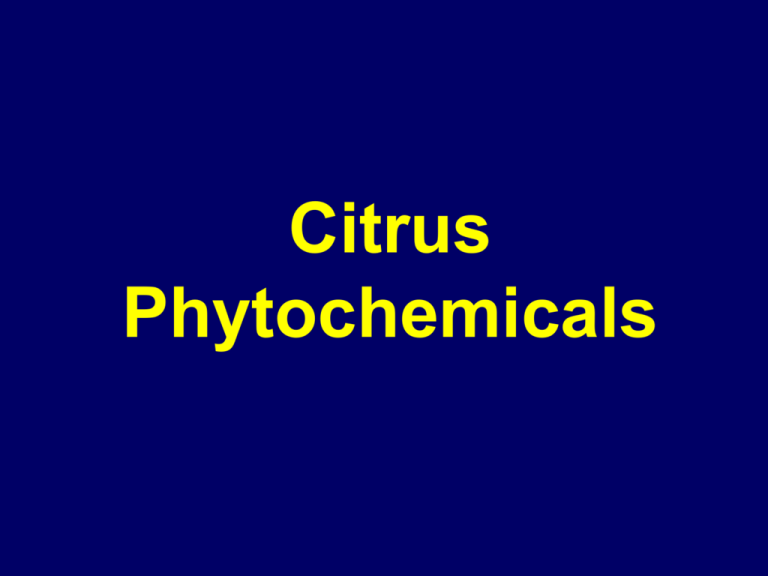
Citrus Phytochemicals Designer Foods Functional Foods Hypernutritious Foods Nutraceuticals Nutraceuticals Nutraceuticals is a generic description of food composites containing natural and biologically active phytochemicals with disease-preventing and life-sustaining functions alone or in combination. Chemopreventive agents • Micronutrients –vitamins, beta carotene, molybdenum, calcium • Phytochemicals • Synthetics –vitamin derivatives –piroxicam –tamoxifen Phytochemicals • Carotenoids • Indole • Saponins • • • • Coumarins Dietary Fiber Isoflavones Protease inhibitors Phytochemicals • • • • Organosulfides Isothiocynates Indoles Dithiolthiones • • • • Polyphenols Flavonoids Tannins Folic acid Contd. Chemopreventive agents (Based on their mechanisms of action) • Blocking agents • Suppressing agents CANCER CHEMOPREVENTIVE AGENTS 1. BLOCKING AGENTS -- prevent carcinogens from reaching or reacting with the DNA, the genetic information. 2. SUPPRESSIVE AGENTS -- inhibit the expression of cancer in cells that have already been exposed to a carcinogen. Cancer Producing Compounds Blocking Agents Cells Attacked By Cancer Producing Compounds Suppressing Agents Cancer Wattenburg, 1993 Chemopreventive agents • Blocking agents – Flavonoids – Indoles – Isothiocynates – Diallyl sulfides – D-limonene MECHANISM OF ACTION (BLOCKING AGENTS) 1. Inhibit the formation of the active carcinogen. 2. Increase the rate at which the active carcinogen is inactivated. 3. Act as scavengers for the active forms of carcinogens. Chemopreventive agents • Suppressing agents –D-limonene –Diallyl sulfides – vitamin D –vitamin A and retinoids –monoterpenes –carotenoids – polyphenols Anticarcingenic mechanisms • Antioxidant effects • Increased activity of enzymes that detoxify carcinogens • Effect on cell differentiation • Blocked formation of nitrosamines • Altered estrogen metabolism • Decreased cell proliferation • Maintenance of normal DNA repair THREE-PHASE MECHANISM FOR CHEMICAL CARCINOGENESIS 1. INITIATION - normal cells to latent tumor cells. 2. PROMOTION - latent tumor cells to carcinoma in situ. 3. PROGRESSION - carcinoma in situ to invasive carcinoma. Procarcinogens Phase I enzymes Phase II enzymes Glutathione S-transferase Carcinogens Electrophiles Limonoids Flavonoids Promotion DNA Damage Lycopene, Lutein, Zeaxanthin and Beta carotene Initiation Oxidative damage Free radicals Tumor Health Promoting Compounds • Carotenoids – Lycopene -Prostate Cancer – Beta carotene – Lutein and zeaxanthin-Blindness – Beta cryptoxanthin Carotenoid Concentrations • Lycopene- Grapefruit – 3362 ug/100 g wet wt (Mangels et al.,1993) – 350 ug/100 g wet wt (Gross et al., 1987) Carotenoid Concentrations (ug/100g) Oranges Pink Grf 1310 Beta Carotene 39 Carotenoids Alpha Carotene Lutein + Zeaxanthin Lycopene White Grf 14 Mandarins Lemons 38 3 20 0 1 20 0 14 0 10 20 12 0 3362 0 0 0 0 0 106 0 149 Beta Cryptoxanthin Food Tomato (fresh) Lycopene content mg/100g 0.88-4.20 Grapefruit (raw pink) Tomato (cooked) Tomato (sauce) 3.36 3.7 6.2 Tomato Paste Tomato soup, condensed Tomato Powder, drum or spray dried 5.40-150.00 7.99 112.63-126.49 Tomato Juice 5.00-11.60 Guava (fresh) Watermelon Papaya (fresh) Ketchup 5.4 2.3 2.00-5.30 9.90-13.44 Clinton, 1998. Nutrition Reviews 56(2):35-51. Lycopene Variation Among Texas Grapefruits 14 ppm 12 10 8 6 4 2 0 a St y b u R r I-4 8 io R ed R R ay R y b u n o rs H e d en y b u ed R n so R T m o h nk i P sh r a M te i h W u D an c n te i h W Beta carotene 10 ug/g fresh wt 8 6 4 2 0 Star Ruby a I-48 b Henderson Rio Red bc cd Ray Ruby Ruby Red Thomson d e f Marsh g Duncan g 16 14 12 10 8 6 4 2 0 Texas a Florida b Lycopene Beta carotene Texas Florida LIMONOIDS WITH ANTICANCER ACTIVITY • Limonin • Limonin 17-ß-D-glucopyranoside • Limonin carboxymethoxime • Deoxylimonin INACTIVE LIMONOIDS • Limonol • Deoxylimonic acid • Ichangensin • 17,19-didehydrolimonoic acid • Nomilinic acid 17-ß-D-glucopyranoside LIMONOIDS WITH PARTIAL ACTIVITY • Nomilin • Nomilin 17-ß-D-glucopyranoside • Obacunone EPIDEMILOGICAL EVIDENCE 1. 2. 3. 4. oral cavity. larynx. esophagus. stomach. 5. 6. 7. 8. pancreas. lung. colon. rectum. LIMONOID GLUCOSIDES 1. Tasteless. 2. Soluble in water. 3. Human consumption (already present in citrus and citrus products in relatively high concentrations). 4. Can be prepared from by-products of juice processing plants (seeds and citrus molasses). Limonoid Concentrations • Limonoid glucosides – Limonin 17-beta D-glucopyranoside (54-180 ppm) – Oranges-320 ppm – Grapefruit -195 ppm – Lemon-90 ppm • LG 1000 Biological Activity of Citrus Limonoids • Anticarcarcinogenic activities (Lam and Hasegawa, 1989; Lam et al., 1989, 1994; Miller et al., 1989; Gutherie et al., 1997, 1998) • Act as natural pest control agents (Alford et al., 1986; Klocke and Kubo, 1987) • Excellent chemotaxonomic markers (Hasegawa and Ifuku, 1994) O O OAc O O O O Nomilin Limonin O O CH2 OH O O HO OH COOH O O O O -Glucose OAc OH COOH HO O COOH O O Obacunone Glucoside Noimilinic acid Glucoside Cancer cells used (MTT method) • • • • • • The HL-60 (human leukemia cancer) SKOV3 (human ovary cancer) Hela (human cervical cancer cells) BGC-823 (human stomach cancer) Bel-7402 (human liver cancer) MCF-7 human breast cancer cell Percentage of viability of MCF-7 human breast cancer cells 120 100 Nomilin Limonin Glucoside mixture Nomilinic acid glucoside Obacunone glucoside 80 60 40 20 0 -20 0 20 40 60 80 100 120 140 Limonoid concentrations Effect of different limonoids on the percentage of viability MCF-7 cells affected by limoniods. Increasing importance Garlic Cabbage Licorice Soybeans Ginger Umbelliferae (carrots, celery, parsnips) Onions Tea Turmeric Citrus (orange, lemon, grapefruit) Whole Wheat Flax Brown Rice Solanacae (tomato, eggplant, peppers) Cruciferous (broccoli, cauliflower, Brussels sprouts) Oats Rosemary Cantaloupe Mints Oregano Sage Potato Basil Tarragon Cucumber Thyme Chives Barley Berries Foods with cancer preventative properties Health Promoting Compounds • Flavonoids- Breast cancer and heart diseases –Naringin –Hesperetin Antioxidant Activity • Reactive oxygen Species (ROS) play major role many diseases. To counteract ROS and prevent their possible damage to biological molecules all oxygen-consuming organisms have antioxidant systems. • Antioxidant enzymes: superoxide dismuatase, catalase, and glutathione peroxidase. Total Antioxidant capacity • ORAC- Oxygen Radical Absorbance Capacity can be measured by COBAS FARA II analyzer ORAC of commercial orange juice and vitamin C from juice 20 ORAC (micromoles Trolox eq./ml) Grape Grapefruit Tomato Orange Apple 15 10 5 0 Juice Vit. C Juice Vit. C Juice Vit. C Wang et al., 1996. J. Agric. Food Chem. 14(3):701-705. Juice Vit. C Juice Vit. C Antioxidant Activity of Fruits ORAC (micromoles of Trolox equvivalents/g of dry matter) 160 140 120 100 80 60 40 20 0 Strawberry Plum Orange Grapefruit Grapefruit Wang et al., 1996. J. Agric. Food Chem. 14(3):701-705. Tomato Grape Grape Pectin • Used traditionally for jelly preparation • Modified pectin can prevent prostate cancer • Pectin can reduce levels of serum cholesterol How much we need? • To consume about 6g of pectin only about 170 g of grapefruit pulp is sufficient (Baker, 1994) Pectin Content in Different Fruits (% fresh wt) Apples Apricots Bananas Beans Blackberries Carrots Cherries Dewberries Grapes Grapefruit Lemons Loganberries Oranges Raspberries Squash Baker, 1997 0.71-0.84 0.71-1.32 0.59-1.28 0.27-1.11 0.68-1.19 1.17-2.92 0.24-0.54 0.51-1.00 0.09-0.28 3.30-4.50 2.8-2.99 0.59 2.34-2.38 0.97 1.00-2.00 Dietary Fiber Dietary fiber denotes all plant cell wall components that cannot be digested by an animal’s own enzymes. • • • • • • Pectin gums lignin Cellulose Hemicellulose pentosans Citrus Pectin Health Benefits • Modified Citrus Pectin (MCP) prevent cancer metastasis, inhibiting cancer cell proliferation • Hypoglycemic Effect • Hypocholesterolemic Effect • Hemostasis • Modulate human immune function • Detoxification Steps in the process of tumor dissemination Schematic representation of aggregation of tumor cell to normal cell and pectin function Raz and LOtan, 1987 Probable mechanism of pectin hypocholesterol effect Farnandez, et al., 1990 Pectin Hypocholesterolemic Action Pectin Hemostasis Function Pectin can shorten the coagulation time of blood and act as an antagonist of heparin when injected intravenously. Pectin sulfate can behave as strong anticoagulant. Parts of the citrus fruit which contain pectin Components of Pectin • • • • • • • Molecular Weight Polygalacturonic Acid Galacturonic Acid Content Methoxyl Esters Neutral Sugar Content Ions Proteins Structure of Pectin Rhamnogalacturonan Side Chain Linear galacturonan Structure of Pectin Modified Citrus Pectin • Mol Wt should be less than 10 KD • MC should be less than 8% • Galactose and uronic acid may enhance the effect • Higher Mol Wt and higher MC increase its hypocholesterol effect. Pienta et al., 1995; Briggs 1997 Fibroblast Growth Factor Signaling System Factor-Receptor • Cell needs to communicate to each other. • Fibroblast growth factor (FGF) is ubiquitous and a mediator of developmental processes in the embryo and homeostasis. • Inappropriate FGF signal transduction may contribute to defect, tumor growth, cardiovascular disease, diabetes, etc. Components of FGF • FGF factor, currently 19 gene products) • FGF receptor, (Transmembrane tyrosine kinases) currently 4 gene products • Heparan sulfate proteoglycans (FGFRHS) FGFR Stimulation FGF FGFR FGF FGFR FGF Inhibition FGFR FGF No Stimulation No Inhibition Inhibitors (Heparin Mimics) • • • • • • Suramin Suramin analogs pentosan polysulfate Carrageenans Dextran Dextran derivatives FPLC Elution Profile Variation of Pectin Content and Composition in Different Citrus Species Extraction Rate (% of fresh weight) Pectin Extraction Rate in Different Citrus Species 6.00 F/A L 5.00 4.00 3.00 2.00 1.00 0.00 d b lem a a tan b b org c b gra Changes of Pectin Content and Composition Due to Harvest Season Extraction Rate (% of fresh weight) Pectin Extraction Rate 6 F A 5 4 3 2 1 0 Aug Sep Nov Jan Mar May L Variation of Pectin Sugar Content mg/g of Pectin Weight 200 F 180 A 160 140 120 100 80 60 40 20 0 Aug Sep Nov Jan Mar May L Variation of pectin sugar composition Percentage (% of total sugar wt.) 70 rhamnose mannose arabinose galactose xylose glucose 60 50 40 30 20 10 0 Aug Sep Nov Jan Harvest Month Mar May In Vitro Effects of Citrus Pectin on the FGF Signaling System Specific bound (% of control) Pectin Inhibit FGF-1 Binding to FGFR1 100 80 60 40 20 0 -20 0 3 30 Pectin Concentration (g/ml) 300 Pectin Inhibit FGF-1 Binding to FGFR1 % of Maximum Binding 120 Pectin Added Heparin Only 100 80 60 40 20 0 0 0.001 0.01 0.1 1 Heparin Concentration (g/ml) 10 Autoradiography of pectin inhibition activity Inhibition activities of pectin Flavedo/Albedo Lamella Inhibition Activity 1 0.8 0.6 0.4 0.2 0 -0.2 a c Lemon a a Grapefruit a b Tangerine Citrus Species a b Orange Inhibition activities of pectin F A L Inhibition Activity 1 0.8 0.6 0.4 0.2 0 a a ab AUG a a ab SEP a a a a a NOV a b ab JAN a a b MAR a a bc MAY Increasing importance Garlic Cabbage Licorice Soybeans Ginger Umbelliferae (carrots, celery, parsnips) Onions Tea Turmeric Citrus (orange, lemon, grapefruit) Whole Wheat Flax Brown Rice Solanacae (tomato, eggplant, peppers) Cruciferous (broccoli, cauliflower, Brussels sprouts) Oats Rosemary Cantaloupe Mints Oregano Sage Potato Basil Tarragon Cucumber Thyme Chives Barley Berries Foods with cancer preventative properties Case Control and Cohort Studies of All Types of Cancer Fruit Vegetables No. of studies Inverse Positive 55 9 Fruits 29 5 Tomatoes 35 10 Carrots 50 7 Citrus Fruit 26 6 Phytochemicals in Fruits and Vegetables to Improve Human Health Project Director: Bhimu Patil Collaborators: Drs. L.M.Pike, D. R. Lineberger, W. L. McKeehan, Rosemary Walzem E. G. Miller, G. B. Cobb, K.E. Dooley, N. Turner, Lisa Appelt, and M. Skaria, Texas A&M University System Dr. G.D. Stoner, Ohio State University Dr. J. W. Fahey, Johns Hopkins University Dr. I. G. Goldman, Univ. of Wisconison Dr. J. Heimendinger, AMC Cancer Research Center Dr. Fred Kachik, Univ. of Maryland Dr. M. Farooqui, University of Texas, Pan-American Dr. Gene Lester, USDA-ARS Weslaco Dr. Clare Hasler, University of Illionois College Station, Kingsville, Weslaco, Lubbock, Houston, Dallas, Stephenville, Start date: Spring 2001 http:// Phytochemicals.tamu.edu
